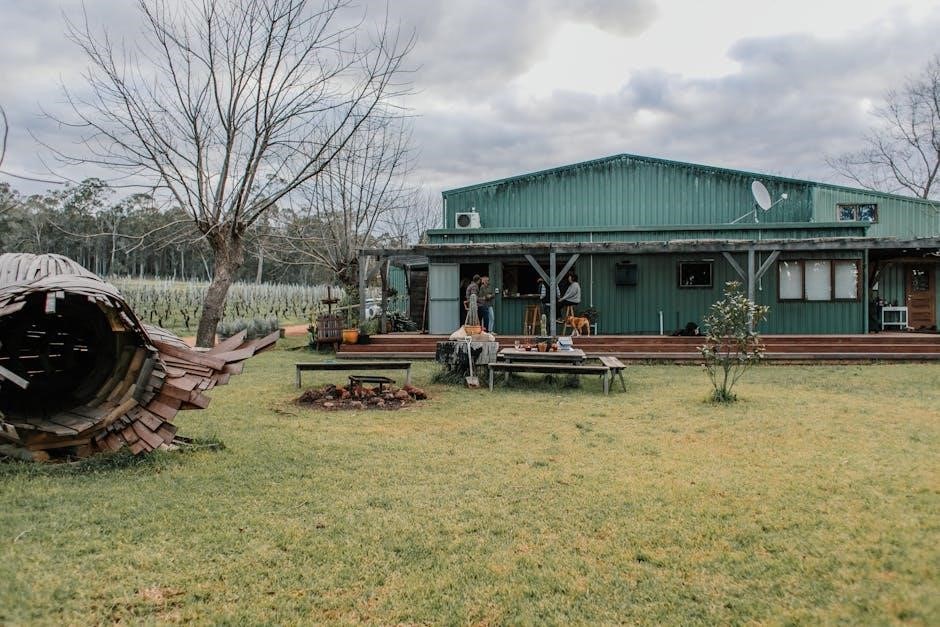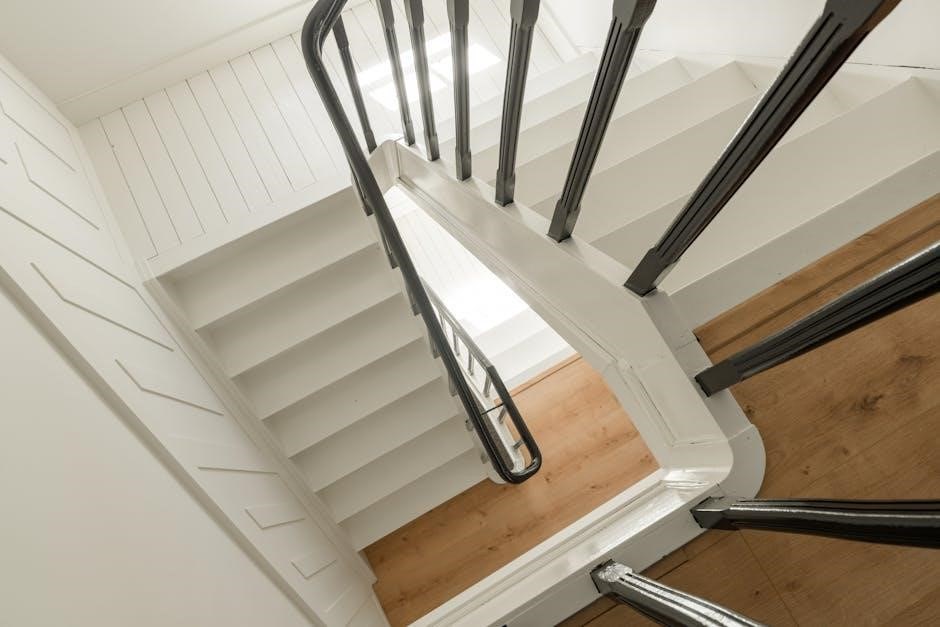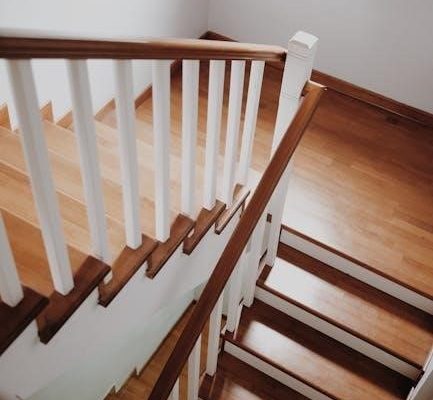Prescriptive residential wood deck construction guides provide essential standards for safe and durable deck building. These guidelines, often based on the IRC, ensure compliance with local building codes and minimize structural risks. By adhering to these guidelines, homeowners and contractors can build decks that are both functional and aesthetically pleasing while ensuring safety and longevity. Proper design and material selection are critical to achieving these goals.

1.1 Overview of the Importance of Prescriptive Guides
Prescriptive guides play a crucial role in ensuring the safety and structural integrity of residential wood decks. These guidelines provide standardized methods for designing and constructing decks, minimizing the risk of collapse and ensuring compliance with local building codes. By following prescriptive guides, homeowners and contractors can avoid common pitfalls, such as inadequate footings or improper fastening techniques. These guides also address material selection, load calculations, and safety features, ensuring decks are built to withstand various environmental conditions. Additionally, prescriptive guides help streamline the construction process, reducing confusion and potential errors. They are essential for maintaining consistency and quality in deck construction, ultimately protecting lives and property while ensuring long-term durability.

1.2 Brief History of Deck Construction Standards
The evolution of deck construction standards reflects advancements in safety, materials, and engineering; Early deck building practices were often empirical, with designs varying widely and lacking uniformity. The introduction of the International Residential Code (IRC) marked a significant shift, providing standardized guidelines for deck construction. Over the years, these standards have been refined to address common failures, such as ledger board detachment and improper fastening. Historical updates to the IRC have incorporated improved methods for footings, joist spans, and guardrail requirements. These changes reflect lessons learned from past structural failures and the need for safer, more durable decks. The development of prescriptive guides has been instrumental in reducing risks and ensuring decks meet modern safety expectations.
1.3 Purpose of the IRC in Deck Construction
The International Residential Code (IRC) plays a critical role in deck construction by providing standardized guidelines to ensure safety, durability, and compliance with local building regulations. The IRC addresses key aspects such as load calculations, material specifications, and construction practices, helping to prevent common issues like ledger board detachment and structural failures. It offers prescriptive requirements for deck components, including footings, framing, and railings, ensuring that decks are built to withstand various environmental conditions. By following the IRC, contractors and homeowners can avoid costly errors and create decks that meet both safety and aesthetic standards. The IRC also serves as a reference for inspections and certifications, ensuring that decks are constructed to last and protect occupants from potential hazards.

Planning and Designing Your Wood Deck
Planning and designing your wood deck involves evaluating site conditions, obtaining permits, and selecting materials. Ensure your design meets local regulations and IRC standards for safety and durability.

2.1 Evaluating Site Conditions and Local Regulations
Evaluating site conditions and local regulations is crucial for a successful wood deck project. Assess the slope, drainage, and soil type to ensure proper foundation planning. Check local building codes, zoning laws, and permits required. Consider environmental factors like weather patterns and moisture levels, which may affect material choices. Familiarize yourself with IRC guidelines to ensure compliance. Verify setbacks from property lines and neighboring structures. Identify any easements or utility lines that could impact construction. Ensure the design accommodates load-bearing capacities and safety standards for guardrails and stairs. Proper site evaluation and regulatory compliance lay the foundation for a structurally sound and legally approved deck. This step ensures your project meets all necessary requirements before construction begins.
2.2 Obtaining Necessary Permits and Approvals
Obtaining necessary permits and approvals is a critical step in the deck construction process. Begin by submitting detailed plans, including deck design, materials, and site layout, to your local building department. Ensure compliance with IRC standards and local ordinances. Secure a building permit before commencing construction, as this ensures your project meets safety and structural requirements. Schedule inspections at key stages, such as footing installation and framing completion, to verify compliance. Failure to obtain proper permits can result in fines or project delays. Additionally, some jurisdictions may require zoning approvals or homeowners’ association clearance. Proper documentation and adherence to permitting processes ensure a smooth and lawful construction experience. Always verify permit requirements early to avoid setbacks later.

2.3 Choosing the Right Wood and Materials
Selecting the appropriate wood and materials is crucial for a durable and safe deck. Pressure-treated lumber is ideal for structural components like posts and joists due to its resistance to rot and insects. For decking boards, consider naturally durable woods such as redwood or cedar, or opt for composite materials for low-maintenance options. Always verify that the wood meets local building codes and IRC standards. Fasteners and connectors should be corrosion-resistant, especially when used with pressure-treated wood. Proper material selection ensures longevity, safety, and aesthetic appeal. Additionally, consider factors like climate, budget, and desired appearance when making your choices. Using high-quality materials adhering to prescriptive guidelines helps prevent structural issues and ensures compliance with safety standards. This step is vital for achieving a sturdy and visually appealing deck. Always consult local suppliers for regionally appropriate options.
Construction Requirements
Construction requirements ensure decks are safe and structurally sound. Key elements include proper footings, framing, decking, railings, stairs, and ledger board connections. These components ensure stability and durability.
3.1 Footings and Foundations
Footings and foundations are critical for deck stability. Properly sized footings prevent settling and ensure a level base. They must extend below the frost line to avoid shifting due to freezing temperatures. Foundations distribute the deck’s weight evenly, preventing soil erosion and structural damage. Local building codes and soil conditions determine footing depth and width. Concrete footings are typically used, with steel reinforcement for added strength. Inspections are required to ensure compliance with IRC standards. Proper installation ensures the deck remains secure and level over time, providing a solid base for the entire structure. Regular maintenance checks are essential to identify any potential issues early.

3.2 Framing and Joist Installation
Framing and joist installation are key steps in deck construction. Joists must be properly sized and spaced according to IRC standards, typically 16 or 20 inches on-center. Lumber type and grade are critical for load-bearing capacity. Joists are attached to the ledger board and rim joist, forming the deck’s structural frame. Ledger boards must be securely fastened to the house using lag screws or through-bolts to prevent detachment. Rim joists, wrapping the deck’s perimeter, enhance structural integrity. Joist hangers or decking screws ensure secure connections. Proper spacing and alignment prevent sagging and ensure even weight distribution. Local building codes may require additional reinforcement. Regular inspections are essential to identify potential issues early. Adhering to these guidelines ensures a safe and durable deck structure, compliant with residential construction standards.
3.3 Decking Board Layout and Fastening
Proper decking board layout and fastening are crucial for safety and aesthetics. Decking boards should be installed with consistent spacing (1/4 inch to 1/2 inch) to allow for expansion and drainage. Pressure-treated, composite, or natural wood decking options are available, each with specific installation requirements. Fastening methods include screws, nails, or hidden fasteners. Screws provide superior holding power, while hidden fasteners create a sleek, gap-free appearance. Boards should be aligned with the house or at a 45-degree angle for visual appeal. Joist locations must be marked for accurate fastening. Proper gapping around posts and between boards is essential to prevent warping. Always follow IRC guidelines for fastener type, spacing, and torque to ensure structural integrity and longevity of the deck.
3.4 Railings and Guards
Railings and guards are essential safety features for residential wood decks, preventing accidents and ensuring code compliance. Railings must be at least 36 inches tall, while guards (for elevated decks) require a minimum height of 36 inches. Both must withstand a lateral load of 50 pounds per square foot. Materials range from wood to metal or composite, with design options to match deck aesthetics. Vertical pickets or balusters should be spaced no more than 4 inches apart to prevent small children from slipping through. Post-to-railing connections must be secure, using lag screws or bolts. Regular inspections are critical to ensure structural integrity and safety. Properly installed railings and guards not only meet IRC standards but also enhance the deck’s functionality and visual appeal while protecting users of all ages. Compliance with local building codes is non-negotiable.
3.5 Stair Construction and Safety
Stair construction is a critical component of deck safety, requiring adherence to prescriptive guidelines to ensure functionality and safety. Stringers must be properly supported, with mid-span support required for stringers over 6 feet. Solid stringers can span up to 13 feet without additional support. Tread depth should be a minimum of 10 inches, with risers ranging from 4 to 7 inches. Uniformity in step dimensions is essential to prevent tripping hazards. Railings are mandatory for stairs with more than three risers, meeting the same height and structural requirements as deck railings. Stringer-to-deck and stringer-to-landing connections must be secure, using appropriate fasteners. Regular inspections are vital to identify and address wear or structural issues promptly. Proper stair construction ensures safe access and compliance with IRC standards, protecting users from potential accidents. Attention to detail in design and installation is paramount for longevity and safety.
3.6 Ledger Board and Rim Joist Connections
Ledger board and rim joist connections are critical for ensuring the structural integrity and safety of a wood deck. The ledger board must be securely fastened to the house using lag screws or through-bolts, spaced no more than 16 inches apart. Rim joists should be properly aligned and connected to the ledger board and deck framing. Use of appropriate fasteners and connectors, such as joist hangers or screws, is essential. Flashing installation around the ledger board is required to prevent water infiltration and rot. Additionally, the rim joist must be reinforced with screws or nails to ensure stability. Proper materials and techniques are vital to meet IRC standards and prevent potential failures. Always verify local building codes for specific requirements. Following these guidelines ensures a secure and durable connection between the deck and the house. Regular inspections are recommended to maintain structural integrity. Ledger board and rim joist connections are non-negotiable for a safe and long-lasting deck.
Safety Considerations
Safety is paramount in deck construction, ensuring durability and preventing hazards. Proper load calculations, secure railings, and fire-resistant materials are essential to safeguard against collapses and fires, protecting users and property.
4.1 Load Calculations and Weight Limits
Load calculations are critical to ensure a deck can safely support intended weights. The IRC specifies minimum load requirements, typically 40 psf for residential decks, accounting for people, furniture, and snow. Proper calculations ensure the structure can handle static and dynamic loads without failure. Factors like joist spacing, beam size, and post footings are considered to distribute weight evenly. Exceeding weight limits can lead to structural instability or collapse. Contractors must verify local building codes, as some areas may require higher load capacities due to climatic conditions. Accurate load calculations prevent safety hazards and ensure compliance with prescriptive guidelines, safeguarding both the deck and its users. Regular inspections are recommended to maintain structural integrity over time.
4.2 Electrical and Lighting Installations
Electrical and lighting installations on wood decks require careful planning to ensure safety and functionality. All electrical components must comply with local building codes and the National Electric Code (NEC). Outdoor-rated materials are essential to withstand weather conditions. GFCI (Ground Fault Circuit Interrupter) protection is mandatory for outlets near water sources. Lighting options include LED, solar-powered, or low-voltage systems, which are energy-efficient and durable. Proper installation of outlets, switches, and wiring is critical to prevent hazards. Hiring a licensed electrician is recommended to ensure compliance and safety. Regular inspections and maintenance of electrical systems are necessary to identify and address potential issues. Proper lighting enhances both aesthetics and safety, making the deck usable during nighttime. Always follow manufacturer guidelines for installation and upkeep of electrical components.
4.3 Fire-Resistant Materials and Treatments
Using fire-resistant materials and treatments is crucial for enhancing the safety of residential wood decks, especially in fire-prone areas. Pressure-treated wood and fire-retardant-coated lumber are commonly recommended options. These materials are designed to slow the spread of fire, providing additional time for evacuation. Natural wood species like redwood and cedar have inherent fire-resistant properties and are often preferred for their durability. Regular maintenance, such as sealing treated wood and removing flammable debris, is essential to preserve fire resistance. Local building codes may require specific treatments or materials, particularly in wildland-urban interface zones. While these measures reduce fire risks, they do not make decks completely fireproof. Proper installation and ongoing care are vital to ensure the effectiveness of fire-resistant materials and treatments.

Inspections and Compliance
Inspections ensure structural integrity and code compliance, crucial for safety. Pre-construction checks verify plans, while final inspections confirm completion. Both prevent hazards and ensure adherence to regulations.
5.1 Pre-Construction Inspections
Pre-construction inspections are critical to ensure compliance with local building codes and the IRC. These inspections verify that the deck design meets structural requirements, including proper footings, framing, and materials. Inspectors review plans and permits to confirm adherence to safety standards. Site conditions, such as soil stability and drainage, are also assessed to prevent future issues. Conducting these checks before construction begins helps identify potential problems early, avoiding costly repairs. Local building authorities typically oversee this process to ensure all aspects of the deck design align with prescriptive guidelines. This step is essential for maintaining safety and structural integrity throughout the deck’s lifespan.
5.2 Final Inspection and Certification
The final inspection and certification are the last steps before a deck is deemed safe for use. Conducted by local building authorities, this inspection ensures all work complies with the IRC and local codes. Inspectors verify structural components, railings, decking, and connections for safety and durability. Any deviations from approved plans or codes must be corrected before certification. Once passed, a certificate of occupancy or completion is issued, confirming the deck meets legal and safety standards. This process is crucial for ensuring the deck is structurally sound and safe for long-term use. Proper certification also protects homeowners from potential legal issues and ensures the deck’s longevity.

Maintenance and Repair
Regular cleaning, inspections, and timely repairs are essential for maintaining a wood deck’s safety and durability. Inspect structural elements annually and address any damage promptly to prevent deterioration.
6.1 Regular Maintenance Practices
Regular maintenance is crucial for extending the life and safety of a wood deck. Homeowners should inspect the deck annually for signs of wear, rot, or insect damage. Cleaning the deck surface with a mild detergent and water helps prevent mold and mildew buildup. Ensuring proper drainage and trimming vegetation around the deck can reduce moisture accumulation. Checking fasteners and connections for looseness and corrosion is essential to maintain structural integrity. Applying a water-repellent sealant or stain every few years protects the wood from weathering. Addressing minor issues promptly prevents them from becoming major repairs, ensuring the deck remains safe and functional for years to come.

6.2 Identifying and Addressing Structural Issues
Identifying structural issues in a wood deck is critical for ensuring safety and preventing costly repairs. Regular inspections should focus on checking for rot, insect damage, or splits in decking boards, joists, and beams. Look for signs of movement or instability, such as loose connections or uneven surfaces. Addressing these issues promptly is essential to maintain the deck’s structural integrity. For minor damage, such as small rot areas, replacing the affected boards or reinforcing them with brackets may suffice. However, for more severe problems, like failing footings or corroded fasteners, professional intervention is often required. Always use materials and repair methods compliant with local building codes to ensure long-term durability and safety.
Adhering to prescriptive guides ensures safe, durable, and compliant wood deck construction. By following established standards, homeowners achieve functional outdoor spaces while addressing future trends in building practices.
7.1 Summary of Key Takeaways
7.2 Future Trends in Deck Construction
Future trends in deck construction emphasize sustainability, durability, and innovative design. The increasing popularity of composite and recycled materials is expected to dominate the market, offering low-maintenance and eco-friendly options. Modular deck systems and prefabricated components are also gaining traction, allowing for faster installation and reduced waste. Smart technology integration, such as lighting and heating systems, is becoming more common, enhancing functionality and comfort. Additionally, there is a growing focus on fire-resistant treatments and materials to improve safety. Design trends are shifting toward multi-level decks and creative use of space, blending seamlessly with indoor living areas. These advancements aim to balance aesthetics, functionality, and environmental responsibility, setting new standards for modern deck construction.



